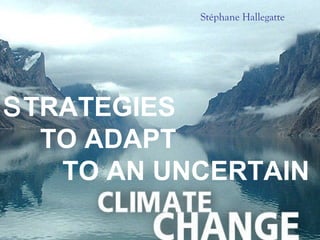
Climate Change
- 1. Stéphane Hallegatte STRATEGIES TO ADAPT TO AN UNCERTAIN
- 3. – The SubjecT headingS: 1. Introduction 2. Long-term Investments and Climate Uncertainty 3. New Strategies to adapt to new Climates 4. Practical Solutions to Increase Robustness 5. Conclusion
- 4. STraTegıeS To adaPT To an uncerTain cLiMaTe change • There is an increasing agreement that many decisions already need to take into account climate change... • Urbanisation plans • Risk management strategies • Infrastructure development for water management • Transportation • Building designs and norms • Over 50- 200 years
- 5. Sector Time scale Exposure (year) Water infrastructures (e.g., dams, 30–200 +++ reservoirs) Land-use planning (e.g., in flood plain or >100 +++ coastal areas) Coastline and flood defences (e.g., dikes, >50 +++ sea walls) Building and housing (e.g., insulation, 30–150 ++ windows) Transportation infrastructure (e.g., port, 30–200 + bridges) Urbanism (e.g., urban density, parks) >100 + Energy production (e.g., nuclear plant 20–70 + cooling system)
- 6. STraTegıeS To adaPT To an uncerTain cLiMaTe change • Significant rise in awareness worldwide • In the past: could be observed and measured • Not just a change in climate conditions • Now and in the future: dramatic increase in uncertainty • New decision-making methods should be developed
- 7. STraTegıeS To adaPT To an uncerTain cLiMaTe change • 2.Long TerM inveSTMenTS and cLiMaTe uncerTainTy: • Two problems make guessing about future climate impossible which are: • 1. A scale misfit between what can be provided by climate models and what is needed by decision makers • 2. Climate change uncertainty is significant
- 8. STraTegıeS To adaPT To an uncerTain cLiMaTe change WhaT ı S a cLiMaTe ModeL? • Global climate models (GCMs) is a model to describe how the atmosphere, the oceans, the land, living things, ice, and energy from the Sun affect each other and Earth's climate. • Thousands of climate researchers use global climate models to better understand how global changes such as increasing greenhouses gases or decreasing Arctic sea ice will affect the Earth. The models are used to look hundreds of years into the future, so that we can predict how our planet’s climate will likely change.
- 10. STraTegıeS To adaPT To an uncerTain cLiMaTe change 3. neW STraTegieS To adaPT To neW cLiMaTeS Ex. Of investigations: • Detection and attribution studies • Identification, understanding and assessment of uncertainty sources in climate and impact models • Exploration of alternative scenarios and modelling approaches
- 12. STraTegıeS To adaPT To an uncerTain cLiMaTe change • 4. PracTicaL SoLuTionS To increaSe robuSTneSS • No-regret strategies • Reversible Strategies • Safety Margin Strategies • Soft Strategies • Strategies that Reduce Decision-making Time Horizons
- 13. STraTegıeS To adaPT To an uncerTain cLiMaTe change • 1. No-regret Strategies: • Able to cope with climate uncertainty • Yield benefits even in absence of climate change • ( ++ ) Win-win Situation • Ex: Controlling leakages in water pipes
- 14. STraTegıeS To adaPT To an uncerTain cLiMaTe change Q: So why no regret actions are not implemented yet? • Financial and technological constraints – especially in poor countries • Lack of info and transaction costs at the micro level • Institutional and legal constraints
- 15. STraTegıeS To adaPT To an uncerTain cLiMaTe change • 2. Reversible Strategies: • Wise to favour strategies that are reversible and flexible • Aim: keep as low as possible the cost of being wrong about future climate change • ( +) • Ex. Restrictive urban planning
- 16. STraTegıeS To adaPT To an uncerTain cLiMaTe change • 3. Safety Margin Strategies: • Reduce vulnerability at null or low costs • To improve the resilience of infrastructure to future changes • The existance of cheap safety margins is especially important for adaptation measures that are not reversible or flexible
- 17. STraTegıeS To adaPT To an uncerTain cLiMaTe change • 4. Soft Strategies: • Institutional or financial tools can also be efficient • Institutionalization of a long-term planning horizon may help anticipate problems and implement adequate responses • Ex: Land-use plans, insurance schemes, warning systems
- 18. STraTegıeS To adaPT To an uncerTain cLiMaTe change • 5. Strategies that Reduce Decision-making Time Horizons: • Reduce uncertainty and corresponding costs • Already been implemented in the foresty sector • Ex. If houses will be built in an area that may become at risk of flooding if precipitation increases, it may be rational to build cheaper houses with a shorter lifetime instead of high quality houses meant to last100 years.
- 19. STraTegıeS To adaPT To an uncerTain cLiMaTe change • Taking into account conflicts and synergies between strategies: • Adaptation strategies often have side-effects that can be either negative or positive. • There are conflict between adaptation options Ex. Coastal infrastructure X tourism industry • Use of snow making X water availability • Adaptation also interacts with mitigation policies. • Improved building norms -> benefits in terms of energy consumption and reduced greenhouse gas emission
- 20. concLuSion: • End-users have to change the way they make decisions, to introduce climate uncertainty in their everyday operations. In most cases, they know how to do so, since uncertainty is already at the heart of many economic decisions: energy prices, exchange rates, and future technological developments are volatile and uncertain, and cannot be forecasted with precision. In this list of uncertain factors, it is urgent to include future climate conditions, to make sure that all the information climate scientists can produce is used in the most adequate way. If uncertainty is taken into account in all long-term decisions, many infrastructure projects will be better adapted in the future, and climate change impacts will remain lower and more manageable Only such an anticipatory adaptation strategy can buy us the time we need to wait for mitigation policies to become effective.
- 22. Thank you for your attention... Ay ş e Betül Kılıç